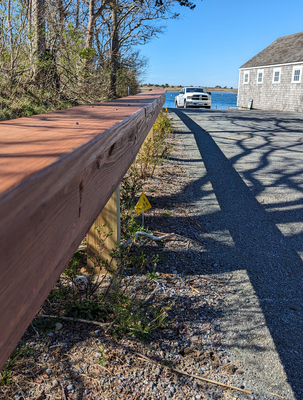Protections Proposed For Town Landings
 The guardrail, built legally by an abutter to the Sears Road town landing, reduced the number of available parking spaces there. ALAN POLLOCK PHOTO
The guardrail, built legally by an abutter to the Sears Road town landing, reduced the number of available parking spaces there. ALAN POLLOCK PHOTO
CHATHAM – Public access to the water needs to be protected against encroachment by private property owners, and some creative steps are needed to do so. That’s the perspective of at least one town committee.
South Coastal Harbor Plan committee chair Tom King made his case to the waterways advisory committee last week, saying action was needed “due to the recent developments at Cow Yard and Sears Road town landings.” In 2022, neighbors complained about traffic jams and parking congestion at Cow Yard, prompting parking restrictions there, and late last year, a neighbor installed a guardrail adjacent to Sears Road landing that limited parking at that access to the water.
“In the future, as multimillion dollar properties change hands, sadly to say, it’s only going to get worse,” King said of the conflicts.
Town staff, supported by town counsel, assert that the town has little recourse when neighbors install fences or vegetation on their own land, even if that land has been traditionally used for public water access.
“The committee recognizes that in most instances, the town’s hands are currently tied when it comes to preventing abutting property owners from exercising their property rights up to their property line abutting town landings,” King said. But after around eight months’ deliberation, the South Coast committee decided that some action is needed.
“We believe that more can be done to highlight protecting our town landings to ensure maximum public access to the town’s waterfront, now and for future generations,” he said.
The committee has proposed an adjustment to the town’s South Coastal Harbor Management Plan that would stipulate that “no abutter to town landings should be allowed to impinge on daily public town landing use. This includes man-made and natural obstructions that would reduce the full access to the town landing’s parking, and where applicable, ramp use,” King said. Any violations would be referred to the select board, the conservation commission and relevant advisory committees.
With regard to the guardrail at Sears Road, waterways committee member Dave Davis said he understands the concern.
“I don’t like it either, but I don’t understand how we can go and tell somebody they can’t put something on their property,” he said. “I’ll support it, but good luck.”
King said some members of his committee have suggested using eminent domain takings to protect town landings, but have been warned that the town has been unsuccessful in previous eminent domain takings. “The town doesn’t have an appetite for that,” he said.
“I don’t know if that’s the right approach we should take to the neighbors of the town landings,” Davis said.
While private landowners have encroached on town landings in the past, it’s also possible that some public landings are partially on private property, King noted. “And so you’ve got to be careful what you ask for,” he said.
A further complication is that some town landings no longer exist because of erosion, like the ones that were once at the end of Claflin Landing, Andrew Harding’s Lane and Holway Street. There, the landings as established are long gone, even though the roads dead-end at the water.
The town already has the authority to clear obstructions from town landings, Coastal Resources Director Ted Keon said. In one case, a neighbor put a fence across the end of a road to keep beachgoers away, and the public works department removed it with a chainsaw.
“As much as I completely support the intent, in essence, you already have this ability,” Keon told the committee. “You can’t put a boulder in the middle of I-95; you’re not allowed. You can’t encroach into a town landing public way now.”
Waterways committee chair Dick Hosmer said committees need clear legal guidance before trying a regulation like the one being proposed.
“Obviously you can do anything you want and take it to court,” he said. Any effort to launch a reasonable, enforceable regulation could lead to “thorny legal issues, and they’re very expensive to figure out,” Hosmer said.
Keon concurred that any regulation would need to pass legal muster, but advised the committees to ask town counsel specific questions to help make that determination.
“If you’re going to say, ‘Can I put a fence outside my town property in the town’s way,’ the answer is ‘No, you can’t,’” Keon said.
Another waterways committee member said any expenditure of time and money is worthwhile to protect public access to the water. Otherwise, town landings tend to disappear over time. Keon said he has no evidence of a case when a formal public landing has been lost to neighbors.
“A path you’ve always used, crossing private property, isn’t a town way, isn’t a town landing,” he said.
Other ideas included using zoning to regulate the placement of structures and vegetation near property lines around town landings, but staff has warned that such efforts would likely be challenged as “spot zoning” because it only applies in certain circumstances. Another proposal is to stipulate protection of adjacent landings when a private parcel is sold. Select board member Cory Metters said it’s better to try and open a dialogue before a property sells. By the time a property is transferred, “it’s almost too late in the game,” he said.
Years ago, the town sent letters to all abutters to town landings, asking if they would be willing to convey part of their land to the town to ensure public access to the water.
“It was a nice try. We didn’t get much,” Keon said. He wasn’t surprised. “If I have a $10 million property, do I want to have more cars parked next to me? Not really,” he said.
King said he plans to bring the proposed regulation to the shellfish advisory committee for its input.
Please support The Cape Cod Chronicle by subscribing today!
You may also like:





